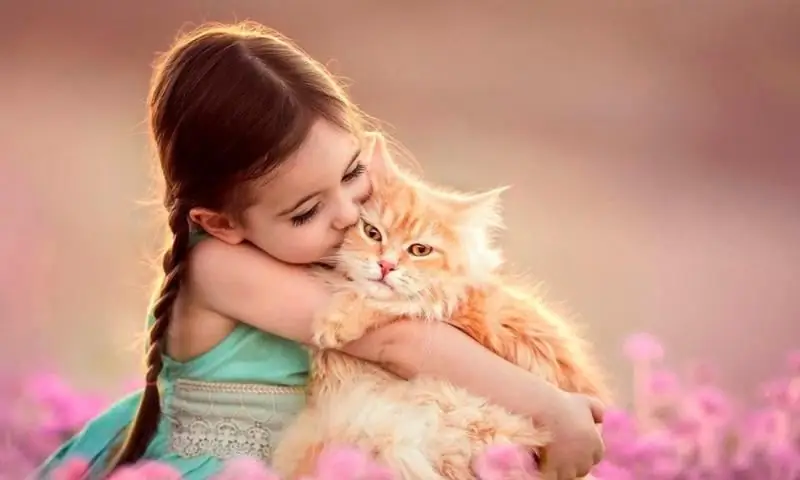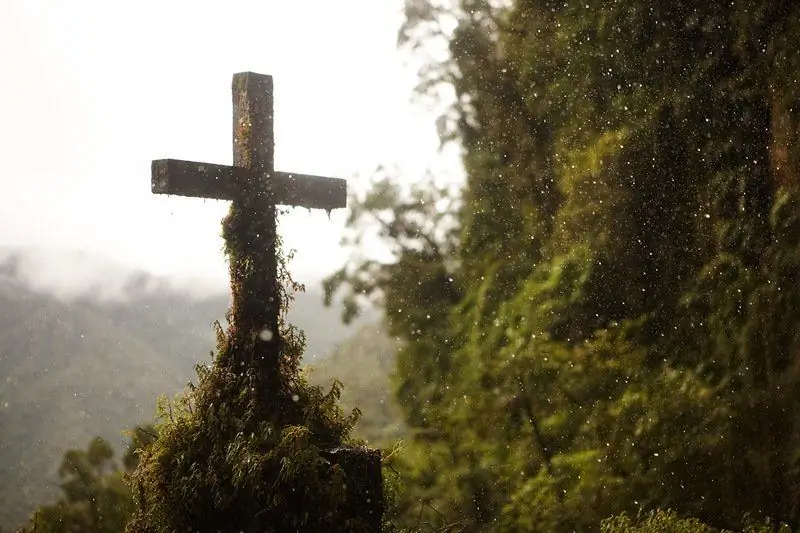
Table of contents:
- 10 famous and unusual monuments to animals from around the world
- Monument to Hachiko in Japan
- Bronze sculpture of the cat Maurice in Odessa
- Bull Monument in New York
- Monument to Chizhik-Pyzhik
- Monument "Give Way to Ducklings" in Boston
- Monument to Greyfriars Bobby in Edinburgh
- Monument to the wolf in Volkovysk
- Monument to laboratory mouse in Novosibirsk
- Monkey Monkey in Hainan
- Monument to a bee in Moscow
- Video: the most famous monuments to animals in the world
- Author Bailey Albertson [email protected].
- Public 2023-12-17 12:53.
- Last modified 2025-01-23 12:41.
10 famous and unusual monuments to animals from around the world

Until recently, all sculptures were monotonous and practically did not differ from each other. Most often, the memory of politicians, writers, scientists and other prominent people was perpetuated. Modern art has stepped forward, and many cities and towns are full of monuments to our smaller brothers.
Monument to Hachiko in Japan
The story of love and devotion to Akita Inu named Hachiko is known all over the world. So, every day, the faithful dog saw off and met his master (professor at the University of Tokyo) from work at Shibuya station. Even after the professor's sudden death, the dog for 9 years came to the station and waited for his friend.
The bronze monument was erected during the life of the faithful dog - in 1934

Hachiko's bones were buried next to the grave of his master, Professor Ueno, in a cemetery called Aoyama in Tokyo, and a stuffed animal was made from the dog's skin, which is still in the local science museum.
When the Hollywood remake of Hachiko: The Most Loyal Friend came out in 2009, I was 20 and my brother was 18. But after watching it, the two of us were so moved that we could not hold back our tears. The brother even decided to get himself an Akita Inu. Now his dog, named Count, is about 7 years old.
Bronze sculpture of the cat Maurice in Odessa
Maurice from Odessa is the favorite cat of satirist Mikhail Zhvanetsky. On April 10, 2018, a bronze sculpture of this legendary cat was installed on the windowsill of the World Club of Odessa residents on Marazlievskaya. The pet is importantly lying on the portfolio of its owner and basking in the sun.

To reproduce exact copies of the cat and the portfolio, the sculptor processed many photographs
Bull Monument in New York
The attacking bronze bull is a symbol of endurance and rebelliousness of the spirit of the American people. It was made after the collapse of the stock exchange in 1989. The sculpture weighs about 3200 kg, its height is 3.4 meters. At first, the bull was placed outside the stock exchange, but due to a protest from the authorities, it had to be moved to Bowling Green Square, near Wall Street. The monument was made at the personal expense of the sculptor Arturo Di Modica, who spent about $ 360,000 on his creation.

In 2004, the creator of the statue, Italian Arturo Di Modica, announced that he was ready to sell the rights to his creation, provided that the buyer left the statue in its original place.
Monument to Chizhik-Pyzhik
The monument to the famous Chizhik-Pyzhik is located in the center of St. Petersburg on the Fontanka River. It was installed on November 19, 1994. Its height is only 11 cm, weight is 5 kg. This piece of art has a very interesting history. So, at the beginning of the 19th century at st. Fontanka Embankment, 6 the Imperial School of Jurisprudence was opened. The uniform of the students was similar to the plumage of a siskin bird - uniforms were green, buttonholes and cuffs were yellow, and fawn served as headdresses.

At the moment, the monument to Chizhik-Pyzhik is the third largest monument in the world, after the Traveler Frog at the entrance to the Tomsk hotel - 44 mm, and little Niels in Stockholm - 10 cm
Like all students, the students of the school loved to have fun. Most often, the meeting place was a tavern on the Fontanka. Hence the song appeared:
Chizhik-fawn, where have you been?
I drank vodka on the Fontanka.
I drank a glass, drank two -
Spun in my head.
Monument "Give Way to Ducklings" in Boston
The bronze monument "Give way to ducklings" is a very cute work of art. This composition of a walking mother duck and her eight ducklings delights visitors to a park in Boston. The sculpture was created based on the American fairy tale of the same name by Robert McCloskey. The ducks are looking for a safe place where they can swim and eat salted peanuts from the hands of park visitors. By the way, even the police are blocking the road to let the marching ducklings pass.
In 1991, on the initiative of Raisa Gorbacheva, a similar monument was erected in Moscow. It is located near the Novodevichesky Monastery and symbolizes the friendship between the peoples of the USSR and the United States.

In 1991, the author's copy of the monument in Boston was placed in a park near the Novodevichy Convent in Moscow
Monument to Greyfriars Bobby in Edinburgh
Another monument of canine devotion is located near the cemetery church in Edinburgh. It was erected in 1873 in honor of the Scottish Skye Terrier named Bobby, who served his master John Gray, a police officer, with truth and faith. When his owner died of tuberculosis, the pet sat for days on end at his grave for 14 years. Only a couple of times a day, he left this place to eat in one of the restaurants. The sculpture is fully consistent with the real size of the faithful dog.

On some especially cold winter days, the dog was taken by someone from the nearby houses
Monument to the wolf in Volkovysk
The wolf is a symbol of the Belarusian Volkovysk. Once upon a time many wolves lived on these lands, for which the city received such a name. In 2005, in honor of the 1000th anniversary of the city, a bronze figure of this predator was erected, lying on a stone pedestal. The monument is located at the intersection of Shkolnaya and Lenin streets. The head of the animal is raised upward, the ears are alert. This suggests that the wolf is always on the alert and ready to defend his city.

The monument immediately overgrown with city signs - you need to rub the nose of the bronze statue in order to find good luck in business, financial well-being
Monument to laboratory mouse in Novosibirsk
The laboratory mouse monument is located in the park near the Institute of Cytology and Genetics of Novosibirsk. It was opened in honor of the 120th anniversary of the city on July 1, 2012. As the director of the institute says, this monument is a kind of gratitude to rodents for the fact that scientists have the opportunity to use them in their experiments.
The sculpture represents a mouse sitting on a granite stone. There are glasses on the tip of the rodent's nose. In its paws, the mouse holds the knitting needles with which it knits a double helix of DNA. But this spiral is left-handed (poorly studied), and not, like most, right-handed. This symbolizes the fact that science has where to develop and what to strive for.

Novosibirsk artist Andrey Kharkevich worked on the image of the mouse
Monkey Monkey in Hainan
Monument to the clever macaque, Monument to Darwin's theory of evolution, Monument to the clever monkey. As soon as this work of sculptural art was not called, in fact, it is a symbol of the centuries-old labor that made a man out of a monkey. In the face of a monkey, Darwin himself appears, who holds his chin with one hand and a human skull with the other, and reflects on the high. He holds an open compass in his leg.
This monument is located on the southern island of Japan - Hainan, Monkey Island.

On the island of Hainan, you can see with your own eyes 2,000 Guan macaques and countless species of other monkeys
Monument to a bee in Moscow
Bee Kuzya, this is how the bronze bee was nicknamed, which is located on the territory of the Kuzminki ecological and educational center. The bee is a symbol of hard work. The sculpture is an insect cast from bronze, which is located on one of three hexagons (the embodiment of honeycomb).
The sculpture was opened in 2005 on the day of the ecological festival in Kuzminki. The author of the sculpture is Sergei Soshnikov.

In Kuzminki Park there was a "residence" of bees of the mayor of Moscow - Yuri Luzhkov - a great fan of beekeeping
Muscovites believe that if you rub your palm against a bee, it will bring good luck.
Video: the most famous monuments to animals in the world
Each monument of sculpture has its own history and significance. One makes us think, the other scares or, conversely, evokes positive emotions. Some monuments to animals are erected in honor of their service to humanity or solely for mood.
Recommended:
The Kindest And Most Affectionate Cat Breeds: The Advantages And Disadvantages Of Such Animals, Features Of Choosing A Pet, Photos

Why affectionate cats are the most popular. Disadvantages of such breeds. Varieties of affectionate cats and their description. The kindest cat in the world. How to choose a cat
Graves By The Road: Why Crosses And Monuments Are Erected On Highways, How Do Drivers Relate To This

Why do they put up crosses and graves near the roads? How drivers and the church feel about it
The Most Poisonous Animals In The World

Deadly animals in the world: photos, names, descriptions of where they live. TOP 10 most poisonous living beings
Funny Names Of Children Of Stars And The Most Unusual

The funniest and ridiculous names that stars give to their children
Unusual And Interesting Facts About Animals: Top 10

A brief description of the amazing animals of our planet. Unusual pet facts. Photos and videos on the topic
